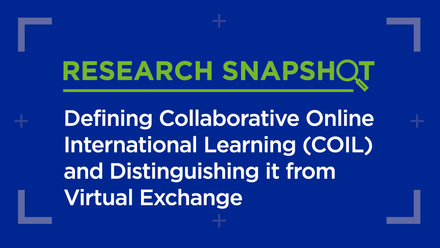Finding a virtual exchange partner: 3 approaches

In the last several years, virtual exchange (VE) – an umbrella term used to refer to the many different ways in which students are engaged in online collaborative learning with partners from other cultures as part of their educational programmes – has definitively entered the mainstream of higher education practice. But despite worldwide recognition as a key pedagogical tool, VE still faces other challenges, one of which is finding the right partner for carrying out a VE project.
One might think that agreeing on student learning outcomes, designing task sequences for learners and making pedagogically-informed technology choices are among the most demanding and time-consuming aspects of VE, for first-timers in particular, but there is another activity which requires even more patience and perseverance: finding a partner. Indeed, as brilliant as your VE project design ideas might be, if you do not find a partner to run this project, your exchange will never happen. So how can an educator or institution go about finding a VE partner?
As brilliant as your VE project ideas might be, if you do not find a partner to run this project, it will never happen
There is no easy answer to this question, since many academics are struggling to find a VE partner, but luckily there are organisations and platforms which can help. Experience shows that there are three avenues for finding a VE partner that deliver results (in no particular order): personal network, university network and platforms/organisations.
Personal network
This first option seems to be the easiest one, since you meet colleagues on a daily basis, you know them, you know their backgrounds and their skills. The personal network, depending on your background and working environment, can be a good start, especially when your job or responsibilities match the VE project you want to set up.
In my case, as a language teacher in the Applied Physics and Measurement Engineering department at the Bordeaux Institute of Technology, my idea for an environmentally-oriented VE on water management surprised my colleagues. Fortunately, since it focuses on irrigation and watering issues, I was able to get their attention. After several meetings and presentations of the topic, they eventually acknowledged the fact that this multidisciplinary project could be useful for our students.
The fact it took me a long time to convince them made me realise that finding a partner among my peers was going to be a tougher experience than I thought, but I was convinced that this VE was a way forward both for the students and myself. When reaching out via your personal network to find a VE partner, be sure to approach people who are keen on pedagogical innovation, present your ideas in a clear and positive way, and accept both negative and positive feedback.
University network
After realising the limits of my personal network, I contacted the International Office of my institution presenting my VE idea and asking for advice as to how I should go about finding a partner. I was soon introduced to international officers who have a more complete and general view of the actions carried out by colleagues. Connecting with them gave me the opportunity to benefit from the experience of colleagues already involved in international actions such as virtual exchanges.
This step is crucial since it gives you access to so much time-saving data. This is particularly useful in terms of getting more familiar with the university portfolio and the university network. The International Office also knows about the various conferences, international events (such as the international week) that might be helpful for partnership development activities and they also know about online platforms that are dedicated to VE.
Platforms/organisations
After checking out several online platforms, such as Gazelle International and Linkr for Virtual Exchange, and following several exchanges with the international officers where I was able to talk about my VE ideas, I was introduced to colleagues from UNICollaboration, a cross-disciplinary professional organisation for telecollaboration and virtual exchange in higher education based in Brussels. I was lucky enough to be accepted in one of their training programmes where I learned more about structuring a VE, organising the different steps and actions. Trainees were invited to join an online partnering fair in the run-up to Christmas 2019, where I was able to introduce myself and my VE project. These platforms not only provide valuable information about the organisation of VE activities and important elements such as learning outcomes, they also offer the possibility to share ideas with other VE enthusiasts. So, when looking for partners, platforms like these are definitely a go-to solution.
Never give up, never despair
However long or difficult the journey to identify a VE partner and get a new course or programme off the ground, the process can allow you to gain new, valuable insights and skills. In my own case, with hindsight, I realise that I have learned to present this project with a view to continuous improvement. I have also learned to formulate my expectations more in dialogue with colleagues and students, and I certainly know more about VE which, of course, helps me to pitch it to potential partners. Working to develop a VE opportunity might at times seem long and difficult: the process of finding ‘the’ partner is not a bed of roses. But, despite the hurdles this journey is exciting and gratifying. Indeed, once you have found a partner, the rest is just a piece of cake.






